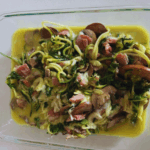Here is my recipe for lower histamine lower sulfur chickpea tofu. This recipe is great if you can’t tolerate soy-based tofu, or if you are looking for a lower-sulfur protein source.
As an Amazon Associate, I earn from qualifying purchases.
Table of Contents
What is MCAS?
Mast Cell Activation Syndrome (MCAS) is a chronic condition that affects all organ systems. MCAS is serious and disabling and people with MCAS experience often significant and debilitating symptoms daily, including anaphylaxis, which can be fatal.MCAS is often found in combination with other chronic conditions such as Ehlers-Danlos Syndrome (EDS) and Postural Orthostatic Tachycardia Syndrome (POTS).
Frequently healthcare providers do not know about MCAS, and the tests for MCAS are problematic because they are not uniformly reliable. MCAS can be difficult to manage. Treatments include blocking mast cell mediators with anti-histamines and mast cell stabilizers, as well as avoiding triggers.
Check out this post on how to manage MCAS.
Why this recipe?
This recipe is made from a legume that is the lowest in sulfur, and it’s free of soy, dairy, grains, and gluten. Eating a diet lower in carbs and inflammatory foods can help to control histamine intolerance. To learn more about the lower histamine diet click here!
Ingredient notes for lower histamine lower sulfur chickpea tofu
This recipe calls for chickpea flour.
The bucket theory
The bucket theory offers a helpful analogy for understanding symptom reactions with MCAS.
Think of your body as an empty bucket you want to keep from overflowing. Different foods and activities fill your histamine bucket at different speeds but combine to form the total histamine level in your body (how full your bucket is). A fuller bucket means you have more histamine symptoms. When you manage triggers, reduce exposure to known triggers, and take medications and supplements to reduce histamine, you can manage the level of your bucket.
Know your typical symptom progression
Knowing your symptom progression in a symptom flare is the key to developing your rescue plan. In this post, I discuss how to determine your symptom progression. Once you know what typically happens in your symptom progression you can design a rescue plan to address those symptoms.
Get my free ebook, symptom log, and meal plan!
Want a tool to easily keep track of your symptoms? Sign up for my newsletter and you will receive my free 50-page ebook of lower-histamine, grain-free, sugar-free recipes, my free symptom log, and a free two-week meal plan!



